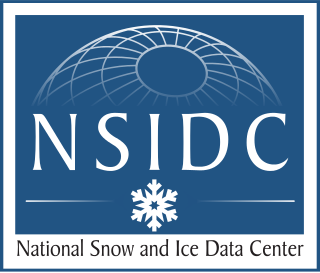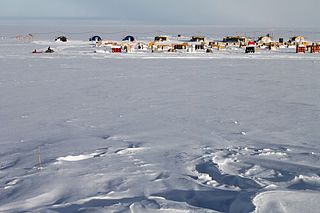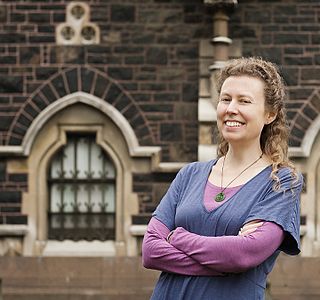
An ice core is a core sample that is typically removed from an ice sheet or a high mountain glacier. Since the ice forms from the incremental buildup of annual layers of snow, lower layers are older than upper ones, and an ice core contains ice formed over a range of years. Cores are drilled with hand augers or powered drills; they can reach depths of over two miles (3.2 km), and contain ice up to 800,000 years old.

The National Snow and Ice Data Center (NSIDC) is a United States information and referral center in support of polar and cryospheric research. NSIDC archives and distributes digital and analog snow and ice data and also maintains information about snow cover, avalanches, glaciers, ice sheets, freshwater ice, sea ice, ground ice, permafrost, atmospheric ice, paleoglaciology, and ice cores.

The Byrd Polar and Climate Research Center (BPCRC) is a polar, alpine, and climate research center at Ohio State University founded in 1960.

Mount Takahe is a 3,460-metre-high (11,350 ft) snow-covered shield volcano in Marie Byrd Land, Antarctica, 200 kilometres (120 mi) from the Amundsen Sea. It is a c. 30-kilometre-wide (19 mi) mountain with parasitic vents and a caldera up to 8 kilometres (5 mi) wide. Most of the volcano is formed by trachytic lava flows, but hyaloclastite is also found. Snow, ice, and glaciers cover most of Mount Takahe. With a volume of 780 km3 (200 cu mi), it is a massive volcano; the parts of the edifice that are buried underneath the West Antarctic Ice Sheet are probably even larger. It is part of the West Antarctic Rift System along with 18 other known volcanoes.

Lonnie Thompson, is an American paleoclimatologist and university professor in the School of Earth Sciences at Ohio State University. He has achieved global recognition for his drilling and analysis of ice cores from ice caps and mountain glaciers in the tropical and sub-tropical regions of the world. He and his wife, Ellen Mosley-Thompson, run the ice core paleoclimatology research group at the Byrd Polar Research Center.

Dome Fuji, also called Dome F or Valkyrie Dome, is an Antarctic base located in the eastern part of Queen Maud Land. With an altitude of 3,810 metres (12,500 ft) above sea level, it is the second-highest summit or ice dome of the East Antarctic Ice Sheet and represents an ice divide. Dome F is the site of Dome Fuji Station, a research station operated by Japan.
Tavi Murray, FLSW is a glaciologist, the eighth woman to be awarded the Polar Medal.
The International Trans-Antarctic Scientific Expedition (ITASE) was created in 1990 with the purpose of studying climate change through research conducted in Antarctica. Antarctica was chosen as the optimal site to study the atmosphere because of its remote location and relatively undisturbed environment. Research in many fields has been conducted in Antarctica through ITASE, including astronomy, atmospheric sciences, biology, earth sciences, environmental science, geology, glaciology, marine biology, oceanography, and geophysics.

The WAIS Divide is the ice flow divide on the West Antarctic Ice Sheet (WAIS) which is a linear boundary that separates the region where the ice flows to the Ross Sea, from the region where the ice flows to the Weddell Sea. It is similar to a continental hydrographic divide.
Elizabeth Mary Morris,, also known as Liz Morris, is a glaciologist and Senior Associate at the Scott Polar Research Institute, University of Cambridge. She has been a visiting professor at the University of Reading since 1995. She was head of the ice and climate division at the British Antarctic Survey, from 1986 to 1999, and president of the International Glaciological Society, from 2002 to 2005.

Mario Giovinetto was an Argentine glaciologist, climatologist and geographer. He was a Canadian citizen with permanent resident status in the United States.

The Antarctic Automatic Weather Station (AWS) Project is an Antarctic research program at the Space Science and Engineering Center at the University of Wisconsin–Madison that is funded by the Office of Polar Programs at the National Science Foundation (NSF). The AWS project was started in 1980 by UW-Madison atmospheric sciences Professor Charles R. Stearns.
Ellen Mosley-Thompson is a glaciologist and climatologist. She is a Distinguished University Professor at Ohio State University and director of their Byrd Polar and Climate Research Center. She is known as a pioneer in the use of ice cores from the Polar Regions for paleoclimatic research and is an influential figure in climate science. She is an elected fellow of the American Association for the Advancement of Science, the American Geophysical Union and an elected member of the National Academy of Sciences.

William Stanley Bryce (Stan) Paterson was a leading British glaciologist. He mined glacial cores which then provided climate data for the world's last 100,000 years.

Christina Hulbe is an American Antarctic researcher, and as of 2016 serves as professor and Dean of Surveying at the University of Otago in New Zealand. She was previously Chair of the Geology Department at Portland State University in Portland, Oregon. She leads the NZARI project to drill through the Ross Ice Shelf and is the namesake of the Hulbe glacier.

Frank Jean-Marie Léon Pattyn is a Belgian glaciologist and professor at the Université libre de Bruxelles. He is best known for developing ice-sheet models and leading model intercomparisons.
Michele Koppes is an associate professor at the University of British Columbia who uses glaciology and geomorphology to study climate and changing landscapes.
Kirsteen Jane Tinto is a glaciologist known for her research on the behavior and subglacial geology of the Greenland and Antarctic ice sheets.

Guðfinna 'Tollý' Aðalgeirsdóttir is professor in Geophysics at the Faculty of Earth Sciences, University of Iceland.













